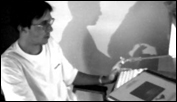
BIOGRAPHY
Nicolas Ducheneaut is a research scientist in the Computer Science Laboratory at the Palo Alto Research Center (PARC). He obtained his Ph.D. in 2003 from the University of California , Berkeley . His research interests include the sociology of online communities, computer-supported cooperative work, and human-computer interaction. He has studied social interactions in a wide variety of environments ranging from real-time, massively multiplayer games to large bureaucracies. These studies led to the design of novel technologies to better support electronic communication in virtual environments. Nicolas's research is based on a combination of qualitative methods (ethnography) with quantitative data collection and analysis (such as data mining and social network analysis). More information is available on his web page.
ABSTRACT
Understanding the nature of avatar-mediated interaction in MMOGs Today millions of people worldwide are playing, living, and learning in virtual worlds known as massively multiplayer online games (MMOGs). Unlike many other genres of video games, MMOGs constitute a medium of social interaction that can be used by thousands of simultaneous remote players. Perhaps the defining characteristic of MMOGs as a form of communication is that they attempt to simulate the experience of face-to-face conversation. Social interaction in them is organized by reference to persistent spaces, inhabited by humanoid bodies (or "avatars"), that can gesture and speak (via text chat and/or voice). At the same time, as simulations they in many ways fall short of and diverge in interesting ways from the real thing. Game designers are perhaps currently less experienced at simulating face-to-face conversation than they are at physics, lighting, human anatomy or body motion. Yet such virtual worlds have proved compelling enough that some are beginning to adapt such game engines for more "serious" endeavors such as real-world education and professional training (e.g., Education Arcade's "Revolution" or Forterra's "Asymmetric Warfare Environment").
So what is it like to interact and collaborate with other real people in these new kinds of worlds? How is it like a face-to-face interaction? How is it not? What are the affordances and limitations of this new communication medium as a potential vehicle for education and learning?
We will explore these questions and more in this 90-minute interactive workshop sponsored by the PlayOn project at PARC (www.parc.com/playon). Participants will gain a detailed understanding of social interaction mechanics in MMOGs by analyzing screen-capture video of actual game play in a variety of games (including EverQuest II, EverQuest Online Adventures, Second Life, Star Wars Galaxies, There and World of Warcraft). By examining how players in these worlds use spatial proximity, public and private chat, gestures, text emotes, and eye gaze, participants will explore interactional issues such as virtual co-presence, joint focus, tight coordination, and mutual understanding. In examining this medium, we will also raise questions about how it may or may not be suitable for educational applications. (If possible participants should bring DVD-capable laptops for viewing MPEG-2 video.)